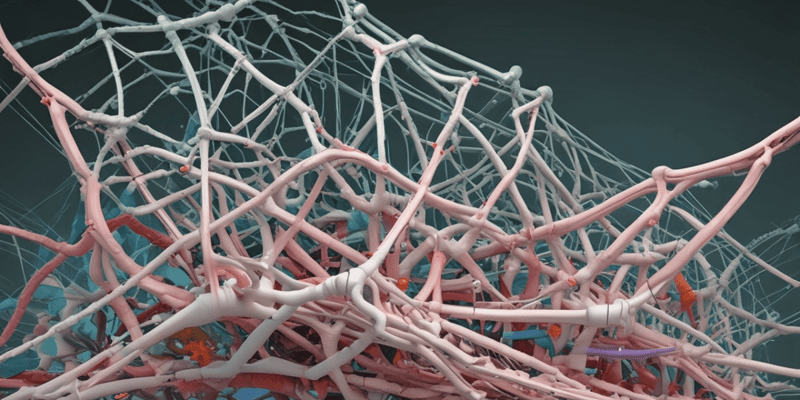30 Questions
What is the main function of disulphide bonds in α-keratin?
To stabilize and strengthen the protein
What is the characteristic feature of α-keratin in Rhinoceros horn?
High proportion of disulphide bonds
What type of structural elements are common in filamentous proteins?
Coiled coils
What is the result of coiled coils combining in the supramolecular structure of α-keratin?
Strengthening of the protein
What is the structure formed by the combination of 4 protofibrils in α-keratin?
Intermediate filament
What is the role of disulphide bonds in the formation of higher order structures in α-keratin?
To stabilize the formation of coiled coils
What is the common feature of the structural elements in filamentous proteins like α-keratin?
Fibrous structures
What is the arrangement of α-keratin helices in the coiled coil structure?
Wound
What is the result of the combination of multiple intermediate filaments in α-keratin?
Formation of a strand of hair
What is the type of protein that is characterized by the presence of coiled coils and disulphide bonds?
α-Keratin
What is the characteristic of the segments rich in proline, glycine, and valine in elastin?
They form β-structure
What is the result of the conversion of the amine groups of lysine to reactive aldehydes by lysyl oxidase in elastin?
Formation of desmosine cross-links
What is the function of desmosine cross-links in elastin?
To provide elasticity
What is the composition of desmosine?
Four lysine residues
What is the process responsible for the formation of desmosine cross-links?
Oxidative deamination of lysine residues
What is the role of tropoelastin in elastin formation?
To form an insoluble complex
What is the importance of elastin in tissue integrity?
To provide elasticity
What is the association of tropoelastin with?
Glycoproteins
What is the result of the formation of desmosine cross-links in elastin?
Elastic properties
What is the molecular weight of tropoelastin?
65kDa
What is the primary characteristic of the amino acids that form α-helix structures in elastin?
High proportion of small and non-polar amino acids, specifically alanine and lysine.
What is the role of lysyl oxidase in the formation of desmosine cross-links in elastin?
Lysyl oxidase converts the amine groups of lysine to reactive aldehydes, resulting in the spontaneous formation of desmosine cross-links.
What is the composition of desmosine, and how does it contribute to elastin's elasticity?
Desmosine is composed of four lysine residues, allowing for bonding to multiple peptide chains and contributing to elastin's elastic properties.
What is the significance of elastin in tissue integrity, particularly in 'elastic' tissues like the lung?
Elastin is essential for tissue integrity, especially in 'elastic' tissues like the lung, where it enables the expansion and contraction of alveoli during gas exchange.
What is the relationship between tropoelastin and elastin, and how do they contribute to the formation of elastin's elastic properties?
Tropoelastin is a ~65kDa protein that is highly cross-linked to form an insoluble complex, which is then converted into elastin, resulting in the formation of elastin's elastic properties.
What is the structural difference between the segments rich in alanine and lysine versus those rich in proline, glycine, and valine in elastin?
Segments rich in alanine and lysine form α-helix structures, while those rich in proline, glycine, and valine form β-structures.
What is the significance of the association of tropoelastin with glycoproteins, such as fibrillin, in the formation of elastin?
The association of tropoelastin with glycoproteins, such as fibrillin, is essential for the formation of elastin, which is then cross-linked to form its elastic properties.
What is the role of oxidative deamination of lysine residues in the formation of desmosine cross-links in elastin?
Oxidative deamination of lysine residues is necessary for the conversion of lysine to reactive aldehydes, which then form desmosine cross-links.
What is the significance of the extensive network of individual polypeptides connected by desmosine cross-links in elastin?
The extensive network of individual polypeptides connected by desmosine cross-links is essential for elastin's elastic properties, allowing it to stretch and return to its original shape.
What is the result of the spontaneous formation of desmosine cross-links in elastin, and how does it contribute to its elastic properties?
The spontaneous formation of desmosine cross-links results in the formation of elastin's elastic properties, allowing it to stretch and return to its original shape.
Learn about the structure of collagen according to Harvey & Ferrier (2011), including the composition of its three α-chains and the common collagen type I found in various tissues. Explore the unique secondary structure and characteristics of collagen.
Make Your Own Quizzes and Flashcards
Convert your notes into interactive study material.
Get started for free



